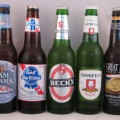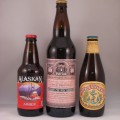How does a German Pilsner differ from a Czech Pilsener? Ever wondered what lagers or pilsners were like before Prohibition in America? Then read on…
Previously we examined Light Lager beer styles, in this article we will cover BJCP Category 2, Pilsner, which includes the following Beer Styles:
First we will cover the history of the category, then take a look at the specifications of each style highlighting the similarities and differences. We then sample a commercial example of each style.
History

Pilsners are a type of pale lager that were first brewed in 1842 in the Czech town called Pilsen, from which the name is derived. These beers require cool fermentation and ‘lagering’ which was only possible in caves back in the 1800’s. Ice was often also used to help maintain cool temperatures as well as extend the brewing period into milder months of the year. With the invention and wider adoption of refrigeration the brewing of this style spread throughout central Europe and into North America by German immigrants. Pilsners are now brewed throughout the world regardless of climate.
Overview
According to Jamil Zainasheff in his book, Brewing Classic Styles, these are all pale lagers but unlike the mass-market, low-flavor lagers covered in our previous article on ‘Light Lagers’, Pilsners all have a greater hop presence (bittering & aroma) making them a much bolder, more flavorful, and aromatic beer-drinking experience.
The following table* shows how the 3 styles of Pilsners vary:
| Characteristic | German Pilsners (Pils) | Bohemian Pilseners | Classic American Pilsners |
|---|---|---|---|
| Original Gravity | 1.044 – 1.050 | 1.044 – 1.056 | 1.044 – 1.060 |
| Final Gravity | 1.008 – 1.013 | 1.013 – 1.017 | 1.010 – 1.015 |
| ABV (alcohol %) | 4.4 – 5.2 | 4.2 – 5.4 | 4.5 – 6.0 |
| IBU’s (bitterness) | 25 – 45 | 35 – 45 | 25 – 40 |
| SRM (color) | 2 – 5 | 3.5 – 6 | 3 – 6 |
The above table shows that German Pilsners and Bohemian Pilseners are similar in ABV with Bohemian Pilseners tending to be hoppier and a little darker in color. Classic American Pilsners can be a little stronger in ABV but the IBU’s are almost exactly the same as German Pilsners.
In the following sections we will look in more detail at each of the above Beer Styles.
German Pilsner (Pils)

Commercial examples of this style from Germany include Bitburger, Jever Pils, Holsten Pils, and Spaten Pils. American examples of this style include Left Hand Polestar Pilsner, Old Dominion Tupper’s Hop Pocket Pils, and Brooklyn Pilsner. We decided to try one from each country, namely Warsteiner Premium Verum and Victory Prima Pils.
Warsteiner has the following characteristics which are at the low end of the style for bitterness and in the middle of the style for alcohol percentage:
- ABV = 4.8%
- IBU’s = 27
The beer was crisp, dry and effervescent as well as light in color and crystal clear. Taste wise it is definitely better in Germany on draft than out of a bottle that has traveled across the Atlantic Ocean!

Victory Prima Pils has the following characteristics which has an alcohol content slightly over the style range but the bitterness is almost 50% over the maximum IBU’s:
- ABV = 5.3% (max ABV are 5.2%)
- IBU’s = 64 (max IBU’s are 45)
Even though Victory Prima Pils is out of style to a degree the taste is much fresher and more lively than the German authentic original in our opinion.
Typical ingredients used when brewing this style include:
- Pilsner malted barley.
- German noble hop varieties such as Hallertauer, Tettnanger and Spalt for both taste and aroma.
- German lager yeast.
Bohemian Pilsener

Note the spelling of Pilsener rather than Pilsner – is this a regional difference?
Commercial examples of this style include Krusovice Imperial 12°, Budweiser Budvar, Czech Rebel, Staropramen, Gambrinus Pilsner, Zlaty Bazant Golden Pheasant, and Dock Street Bohemian Pilsner. In the USA Budvar is called Czechvar due to a long running trademark dispute with Anheuser-Busch as both companies lay claim to the name Budweiser. The name of both Budweiser beers varies between countries depending on who has won the battle within that particular region…
Once again we decided to try two examples, first the one which is probably the most well-known example of this beer, namely Pilsner Urquell, and the other being Sam Adams Noble Pils from Boston Beer Company.
Pilsner Urquell has the following characteristics which is at the low end of the style for alcohol percentage, slightly out of style for IBU’s and in style for color:
- ABV = 4.4%
- IBU’s = 33 (min IBU’s are 35)
- SRM = 4
The beer had a more pleasant aroma than the Warsteiner and a less aggressive flavor in our opinion. In our previous article on Light Lagers we discussed the use of green bottles and how it can impact the flavor and longevity of beer due to light penetration. Pilsner Urquell comes in a green glass bottle and has traveled over land and sea from the Czech Republic to the USA yet tasted surprisingly fresh.

Sam Adams has the following characteristics which are pretty much in style with only the bitterness being slightly low but nothing significant:
- ABV = 4.9%
- IBU’s = 34 (min IBU’s are 35)
- SRM = 5
The beer was easy drinking with a slight hoppy aroma and moderate hoppy flavor offset by a slight maltiness.
Typical ingredients used when brewing this style include:
- Moravian malted barley
- Saaz hops
- Czech lager yeast
Classic American Pilsner

Now for the tough style within the Pilsner category – there are very few commercial examples of this style which dates back to how lagers or pilsners used to be brewed before Prohibition which was between 1920-1933. Commercial examples include Victory Throwback, Boulevard Pilsner, Lucky Bucket Pre-Phibition Lager, Craftsman 1903 Lager (California only), and Avery Joe’s.
The only example we managed to find was Batch 19 Pre-Prohibition Lager from Miller-Coors which has the following characteristics:
- ABV = 5.5%
- IBU’s = 26
The alcohol percentage is within the range though the IBU’s are at the bottom of the style.
This style has in general much more flavor than the post-Prohibition American Lagers that have taken its place. Compared to the other Pilsners within this category the Batch 19 had more malt sweetness and mouth-feel as well as an unusual tang on the tongue. The taste does not linger and finishes relatively quickly. The extra flavor comes from both the higher hopping rate and increased maltiness. Whilst the Batch 19 version had more flavor it would be interesting to sample a more hop-forward example…
Typical ingredients used when brewing this style include:
- Six-row malted barley.
- Flaked corn/maize (20% to 30%).
- Native American hops e.g. Cluster, traditional continental noble hops, or modern noble crosses e.g. Ultra, Liberty, Crystal.
Whilst writing this article a fellow homebrewer from our Black Hops Unit of Centre County club gave some pointers on brewing this particular style (many thanks Phil):
- Use a traditional recipe but instead use modern US hops that have some noble hops in their percentage e.g. Liberty, Crystal.
- Bitterness is 35-40 IBU’s which is at the higher end of the style with moderate flavor hopping and a small amount for aroma (e.g. 1/4 oz per 5 gal batch).
- 20% flaked corn plus a little Aromatic malt.
A malt forward yeast such as WPL833 (German Bock Lager) which is a bit unconventional but works well as WLP800 Pilsner Lager yeast can be a bit too light/crisp.
What next?
Our next article will look at BJCP Category 3, ‘European Amber Lager‘, where we will examine the two styles that originate from Austria and Southern Germany.
If you have any questions or comments about this article, please do not hesitate to contribute to the discussion below.
* Beer Styles’ data is courtesy of BJCP.org.
 Beer Infinity Beer, Brewing & Beyond
Beer Infinity Beer, Brewing & Beyond




